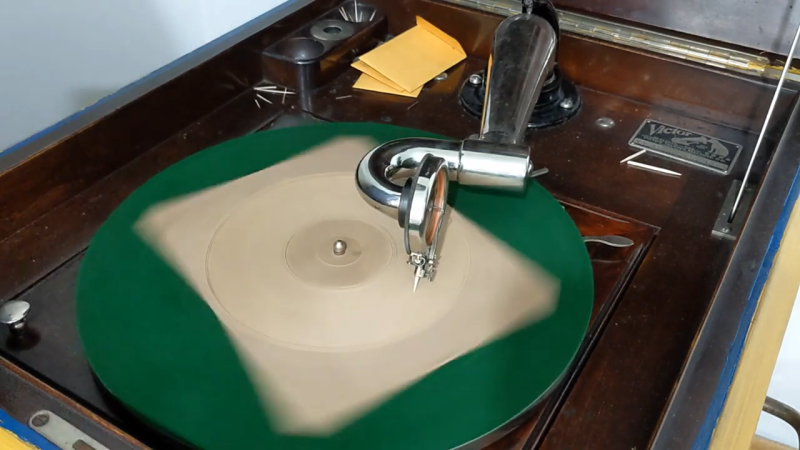Say what you will about [Thomas Edison], but it’s hard to deny the genius of his self-proclaimed personal favorite invention: the phonograph. Capturing sound as physical patterns on a malleable medium was truly revolutionary, and the basic technology that served as the primary medium of recorded sound for more than a century and built several major industries is still alive and kicking today.
With so much technological history behind it, what’s the aspiring inventor to do when the urge to spin your own phonograph records strikes? Easy — cut them from wood with a CNC router. At least that’s how [alnwlsn] rolled after the “one-percent inspiration” hit him while cutting a PCB with his router. Reasoning that the tracks on the copper were probably about as fine as the groove on a record, he came up with some math to describe a fine-pitch spiral groove and overlay data from a sound file, and turn the whole thing into G-code.
For a suitable medium, he turned to the MDF spoil board used to ship PCB stencils, which after about three hours of milling resulted in a rather hairy-looking 78-RPM record. Surprisingly, the record worked fairly well on a wind-up Victrola. The spring-powered motor was a little weak for the heavy wooden record and needed a manual assist, but you can more or less clearly hear the 40-second recording. Even more surprising was how much better the recording sounded when the steel needle was replaced with a chunk of toothpick. You can check out the whole thing in the video below, and you’ll find the G-code generation scripts over on GitHub.
Is all this talk about reproducing music using wiggly lines confusing you? Woah, there, whippersnapper — check out [Jenny]’s primer for the MP3 generation for the background you need.















Does anyone know how they mass produced gramaphone cylinders? The flat press is easy to understand with victrola records, but manufacturing recordings on shellac cylinders not so much.
They didn’t use shellac for cylinders, they used wax and celluloid.
A metal deposition process was used on a wax cylinder to form a “negative” mold. The wax was then melted away, and a blank celluloid cylinder was inserted into the mold. The celluloid was heated and pressed up against the mold with an expandable bladder, which pressed the grooves into the cylinder. The celluloid contracted when cooled, and was then removed from the mold and filled with a harder core material for strengthening.
Aha. The celluloid contracted when cooled. Perfect.
I have a few cylinders, and they seem more like Bakelite.
Here you go: https://www.straightdope.com/21341403/how-did-they-mass-produce-those-old-cylinder-records
Very cool! I’ve been wondering if this is possible and cudos to alnwlsn for getting it working.
It looks like he has the milling down, the big question is what’s a better material. Would a hard epoxy work better or even a metal record?
Don’t get started on this, or soon you’ll have “the Golden Ears”, debating whether Old Growth Oak is better than Honduran mountain grown Teak… or which combination of woods for platter/stylus make for “richer” sound.
Next up, “Wooden it be good” by the Beach Boys.
Hey, we could do a compilation record…
The Beatles – Norwegian Wood
Moody Blues – Driftwood
The Band – Acadian Driftwood
Amii Stewart – Knock On Wood
Elvis Presley – Wooden Heart
And print it on a wood vinyl!
Wood Long Play, i presume, given that its wooden ?
Now I have this image of a one inch think slice of tree trunk on a turntable. Flinstones style.
It wood be interesting to cut a record with no audio input just to see how much of the CNC vibration adds to the noise.
Probably depends mostly on the positional accuracy of the CNC. The LP grooves have an amplitude of about 40 µm. The CNC6040 used in video usually has microstep resolution around 1 µm. The actual resolution is probably a bit worse, but that seems like it would put an upper limit of 30 dB SNR. Factory made vinyl records usually get better than 60 dB SNR.
If you do glass next, record Phillip Glass & call in Glass on Glass.
Waiting for aluminum record with black metal on it. The joke is black metal always sounds like it was recorded on a potatoe, so you wouldn’t know the difference here, hahaha. You’d sell hundreds to black metal hipsters, “artisanally cut using only the finest Norwegian endmills”
convert mechanic needle to optical and meybe a printing in normal printer A4.
I always wanted to make a linear tracking LASER (Optical) record player but by then all of a sudden was a CD payer and the challenge didn’t seem so rewarding.
Those existed: https://en.wikipedia.org/wiki/Laser_turntable
Very interesting read. I wasn’t thinking about this till about ’93, much much later, lasers were cheaper by then but not cheap. Now I see that I would be picking up dust as noise that would otherwise be pushed aside by the stylus. I probably would have solved that problem with a Van de Graaff generator.
Thanks for the link.
Back in the late ’70s (IIRC), a company made a “zero tracking error” turntable that utilized a motor driven tangential tone arm which used an infrared beam for determining the rate the tone arm advanced.
The toothpick isn’t that surprising; Victrolas used thorns as needles: https://i.ebayimg.com/d/w1600/pict/274797285497_/Original-cactus-thorn-gramophone-phonograph-victrola-needles.jpg
And here’s a laser-cut wooden record (I feel like I saw it here first, but I’m too lazy to search the archives right now): https://amandaghassaei.com/projects/laser_cut_record/